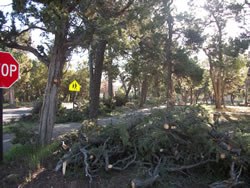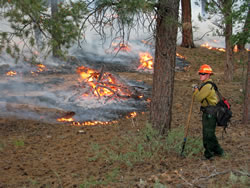National Cohesive Wildland Fire Management Strategy Success Story
Mechanical Fuels Reduction at Grand Canyon
Grand Canyon National Park, Arizona
Cohesive Strategy - Fire-Adapted Human Communities
2011

Fire crews piled thinned vegetation near the Grand Canyon School. NPS photo.

Monitoring burn piles near Market Plaza. NPS photo by Michael Quinn.
In accordance with Grand Canyon National Park’s 2010 Fire Management Plan (FMP) Environmental Impact Statement (EIS), park fire managers have begun expanding tactics of woody biomass utilization, or the use of non-fire treatments to reduce hazardous fuels in the park’s Wildland Urban Interface and fulfill fire ecology and restoration goals.
Fire crews on the South Rim have completed several mechanical projects in 2011 including the 31-acre Market Plaza Thinning Unit in the Market Plaza area, 48 acres in the School Thinning Unit near the Grand Canyon School, and the 13-acre Hopi Tower Thinning Unit surrounding the historic Hopi Point communications/lookout tower. Crews are currently working on the 48 acre Supai Camp Thinning Project just southwest of Grand Canyon Village.
Chainsaws were used to remove limbs and small diameter trees. Some slash was piled, dried and burned under the existing South Rim Prescribed Fire Piles Plan; some was chipped and used in the immediate vicinity to repair erosion caused by social trailing; some was chipped and scattered away from buildings and infrastructure; and the remainder was removed.
The purpose of these thinning projects is to safely create areas of defensible space that will aide in the protection of human life, structures and infrastructure in the event of a wildfire. Reducing hazardous fuels by thinning and limbing trees to open the canopy and removing accumulations of dead and down fuels, helps create and maintain defensible space.
Standards for sizes and amounts of fuels to be removed during these projects were derived from the 2000 National Fire Plan, 2010 FMP EIS, 2006 International Wildland-Urban Interface Code, and recommendations and concurrence from the Grand Canyon Inter-Disciplinary Team.
Contact
Daniel Pearson, South District Assistant Fire Management Officer
Email: Daniel_Pearson@nps.gov
Phone: (928) 638-7934
Keywords: Woody Biomass Utilization, Fire Ecology and Restoration